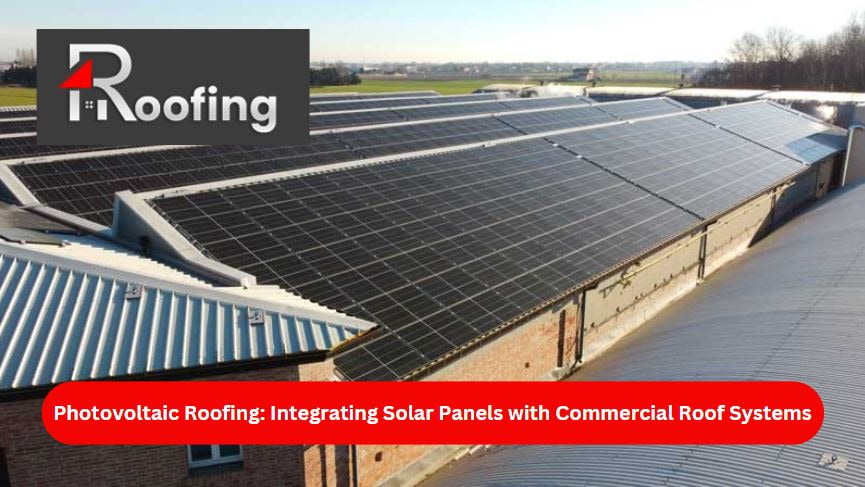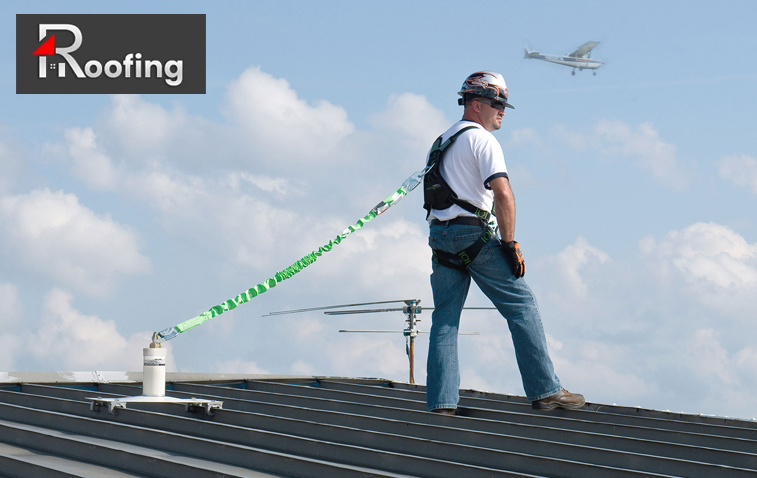Photovoltaic Roofing: Integrating Solar Panels with Commercial Roof Systems
Have you ever imagined a roof that doesn’t just protect your home but also powers it? Photovoltaic roofing systems do exactly that! These innovative roofing solutions harness sunlight and convert it into clean electricity, helping you cut down on energy bills while reducing your environmental impact. With energy efficiency becoming a top priority, PV roofs are a smart choice for homeowners and businesses looking to make their spaces more sustainable. Could a PV roofing system be the eco-friendly upgrade your property needs?

What are Photovoltaic roofing systems?
Solar roofing is a relatively new concept of integrating the photovoltaic system with the roof of a structure to generate electricity. In other words, it implies installation of the solar panels as part of the roofing system for the purpose of generating electricity from light. The idea is simple yet revolutionary: convert your roof into an electricity-generating surface!
Why is Energy Efficiency Important in Roofing?
Energy conservation is thus today beyond being a concept; it is an inevitable reality. With increasing energy costs and a focus on the environment, energy efficient roofing like PV roofing decreases energy use while also lowering a homeowner’s energy bills and offering a key to a better future.
What About Sustainability and Eco-Friendliness?
And that’s not all: photovoltaic roofing systems are not only functional – they are also environmentally friendly. Solar energy enables them to decrease the use of some energy sources that are known to have a negative impact on the environment, lower on the emission of greenhouse gases, and embrace a cleaner skyline.
How Do Photovoltaic Roofing Systems Work?
Sunlight to electricity conversion is the underlying principle of a photovoltaic roofing system. When light from the sun falls on the roof-mounted solar cells, a form of direct current (DC) electricity is produced. Some of this electricity is then changed to usable alternating current (AC) by an inverter.
Key Components in PV Roofing Systems:
- Solar Cells: These foundations are the basic components of the system. Constructed on bases of semiconductors, they absorb solar energy and convert it to electricity.
- Inverters: These devices regulate DC electricity from the solar cell into the AC electricity that you use within your home or business.
- Mounting Systems: These structures support the solar panels, be it installed on roof or on top of the structure.
Types of Photovoltaic Roofing Systems
-
Solar Panel Roof Integration
- What is it? Traditional solar panels are mounted on top of existing roofing structures.
- When to Use? This option is perfect for homeowners or businesses looking to retrofit their existing roof with solar energy capabilities.
- Advantages: Simple to install, cost-effective, and can be applied to most existing roofs.
-
Integrated Photovoltaic (BIPV) Systems
- What is it? In this system, the solar cells are directly embedded into roofing materials like tiles or shingles.
- When to Use? Ideal for new construction projects, where the roofing and solar energy system are built together.
- Advantages: Sleek, aesthetically pleasing, and more integrated into the building’s design.
Benefits of Photovoltaic Roofing Systems
1. Energy Efficiency and Cost Savings
- How Can PV Roofing Save You Money? Solar roofing systems are perfect for saving on your electricity bills. You will have little use for conventional sources of power since your food combines technology to convert sunlight into electricity; therefore, be prepared to spend less on energy bills each month.
- What About Long-Term Savings? Cutting costs are especially fathomable over a long period of time. At first, the cost of installing PV roofing appears to be very expensive, but since the system has a lifespan of a few decades, the benefits accrued from the reduced bills and energy usage quickly offset the initial cost.
2. Environmental Impact
- How Does PV Roofing Help the Environment? One of the biggest benefits of photovoltaic roofing systems is their positive impact on the environment. By generating clean, renewable energy from the sun, you are helping to reduce your carbon footprint. This means fewer harmful emissions, contributing to cleaner air and a healthier planet.
- Why Is Renewable Energy So Important? PV roofing systems promote the use of renewable energy. Solar energy is a sustainable and abundant resource, unlike fossil fuels that are finite and polluting. By embracing solar power, you’re part of the global effort to move towards more sustainable energy solutions.
3. Increased Property Value
- Does PV Roofing Add Value to Your Home? Yes, it does! Homes with energy-efficient roofs and eco-friendly features, like photovoltaic roofing, often see an increase in market value. Buyers are attracted to properties with lower energy costs and a reduced environmental impact.
- What’s the Appeal? Sustainability is becoming a key factor for many homebuyers, especially those looking to reduce their carbon footprint or save money on energy. With photovoltaic roofing, your home becomes a desirable asset in today’s eco-conscious market.
Challenges and Considerations
1. Initial Installation Costs
- Why Is It Expensive to Install PV Roofing? One of the key challenges of photovoltaic (PV) roofing systems is the higher upfront cost. Compared to traditional roofing materials, PV systems can be more expensive due to the technology involved in the solar panels and installation.
- Is It Worth the Investment? Although the initial investment is higher, the long-term benefits—such as lower energy bills and potential property value increase—often make the investment worthwhile. Plus, many regions offer incentives or rebates to help offset the cost.
2. Maintenance Requirements
- How Much Maintenance Does a PV Roof Need? PV roofing systems are relatively low maintenance, but they still require some attention. Regular cleaning is important to ensure the panels stay free of dirt, leaves, or other debris that could block sunlight. Additionally, periodic panel efficiency checks should be done to ensure the system is working at its best.
- Is It Hard to Maintain? Maintenance isn’t very demanding, but it is crucial to keep your system performing efficiently over time. Routine checks can catch any issues before they become costly problems.
3. Roof Compatibility
- Can Any Roof Be Used for PV Roofing? Not every roof is suitable for photovoltaic systems. It’s important to assess structural capacity to ensure the roof can support the weight of the solar panels. Additionally, the roof’s orientation and angle play a major role in the efficiency of the PV system—south-facing roofs with a good pitch are ideal for maximum sunlight exposure.
- How Do I Know If My Roof Is Compatible? A professional evaluation is essential to determine whether your roof is a good fit for photovoltaic installation. They will assess factors like roof age, condition, and location to ensure the system will work effectively.
Comparing Photovoltaic Roofing with Other Green Roofing Solutions
| Criteria |
PV Roofing |
Cool Roofs |
Green (Vegetative) Roofs |
| Energy Output |
Generates electricity from sunlight |
Reflects sunlight to keep the building cooler |
Absorbs heat, reduces energy use in summer |
| Sustainability Impact |
Reduces carbon footprint with renewable energy |
Reduces urban heat island effect |
Increases biodiversity and reduces stormwater runoff |
| Upfront Cost |
Higher initial cost |
Moderate to low cost |
Higher initial cost due to plant installation |
| Maintenance |
Requires cleaning and efficiency checks |
Low maintenance |
High maintenance due to plant care |
| Roof Compatibility |
Requires proper structural capacity and orientation |
Works with most roof types |
Needs structural strength and waterproofing |
Design and Integration Factors
1. Aesthetic Considerations
How Will It Look?
- Photovoltaic roofing can blend seamlessly with your home. Modern solar panels come in sleek, low-profile designs that can actually improve the appearance of your property. Whether you go for traditional panels or a more integrated system, you’ll have a roof that looks stylish while saving energy.
2. Structural Considerations
Can My Roof Handle It?
- Before installing photovoltaic panels, make sure your roof can support them. It’s important to assess the roof’s condition and strength. You may need a professional to check if any reinforcements are necessary to safely install the system.
3. Climate and Location Suitability
Will It Work in My Climate?
- Photovoltaic systems perform best in sunny areas, but they can still work in less sunny regions. The key is ensuring your roof gets enough sunlight. Also, consider your location’s weather—choose materials that can withstand local conditions like wind or snow.
Steps for Installing Photovoltaic Roofing Systems
1. Roof Inspection and Preparation
Why Inspect?
- A roof inspection ensures your roof is in good condition before installing the solar panels. It checks the structure and roof angle, making sure everything is ready for the system. Any repairs should be made first to avoid issues later.
2. Choosing the Right PV System
Which System Is Best for Me?
- There are different types of photovoltaic systems. Depending on your budget, roof type, and energy needs, you’ll need to choose the right one. A professional can guide you through the options and help you select the most efficient system for your home.
3. Professional Installation Process
How Is It Installed?
- Once you’ve chosen the system, professionals will install the panels on your roof. The installation includes securing the panels, wiring them to an inverter, and connecting them to your electrical system. The process can take a few days, depending on the complexity.
Conclusion:
Switching to a Photovoltaic roofing systems is more than just a smart financial move—it’s a step towards a greener future. By generating your own electricity, you reduce reliance on traditional power sources, lower your carbon footprint, and even boost your property value.
While the upfront cost and structural requirements might seem challenging, the long-term benefits often outweigh them. So, are you ready to turn your roof into a powerhouse for clean energy? The future of sustainable living starts right above your head! Bottom of Form


